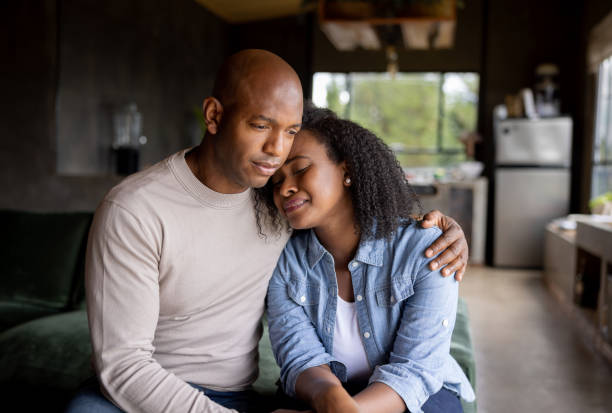Losing a loved one is one of the most profound experiences we face. When that loss happens in hospice care, families may feel a complex mix of emotions — relief that their loved one is no longer suffering, sadness from the loss, and even guilt or confusion. It’s natural to feel overwhelmed, and many people experience a sense of emptiness or disbelief.
The journey through grief is personal, but no one should navigate it alone. The emotional impact can be profound and long-lasting whether the loss was expected or sudden. Understanding grief and finding the right support can help families heal and honor their loved one’s memory, offering a path toward acceptance and emotional recovery.

Understanding Grief
Grief is a natural response to loss, but it affects everyone differently. Some people experience intense sadness, while others may feel numb or even angry. These reactions are normal.
Dr. Elisabeth Kübler-Ross identified five stages of grief — denial, anger, bargaining, depression, and acceptance — but grief is rarely linear. People may move back and forth between stages or experience them in a different order.
For families of hospice patients, anticipatory grief often begins before the loved one passes. This type of grief involves mourning the loss while the person is still alive, preparing emotionally for the inevitable. While anticipatory grief can help families feel more prepared, it doesn’t lessen the pain of the final goodbye.
Coping with Grief After Hospice Loss
Coping with grief is deeply personal, but some strategies can help families navigate the process:
1. Allow Yourself to Feel
Grief brings a whirlwind of emotions. Suppressing feelings can prolong the healing process. Allow yourself to cry, feel angry, or even laugh at memories. Every emotion is part of the journey.
2. Seek Support from Loved Ones
Family and friends can provide comfort and understanding. Lean on your support network and don’t hesitate to express what you need — whether it’s a listening ear or practical help with daily tasks.
3. Consider Professional Counseling
Grief counselors or therapists specializing in loss can provide invaluable guidance. They create a safe space for exploring emotions, developing coping mechanisms, and finding meaning after loss. Organizations like the National Hospice and Palliative Care Organization (NHPCO) offer resources and referrals for grief counseling.
4. Join a Grief Support Group
Connecting with others who have experienced similar losses can be incredibly healing. Hospice organizations often offer support groups for bereaved families. The American Cancer Society and GriefShare also provide local and online groups directories.
5. Memorialize Your Loved One
Creating a lasting tribute can help channel grief into something meaningful. Plant a tree, create a scrapbook, or host a celebration of life. Reflecting on positive memories can bring comfort and promote healing.
6. Prioritize Self-Care
Grief affects the body as well as the mind. Eating nutritious foods, getting regular sleep, and engaging in gentle physical activities like walking or yoga are essential. Avoid turning to alcohol or substances for comfort — they often prolong emotional pain.
Grief Support For Children
Children process loss differently based on their age and developmental stage. Young children may struggle to understand the permanence of death, while teenagers may withdraw or express anger. Open, honest communication is key.
- Use clear, age-appropriate language. Avoid euphemisms like “gone to sleep,” which can confuse young children.
- Encourage questions. Let children ask about death and reassure them their emotions are valid.
- Involve them in goodbyes. Allow children to participate in memorial services if they choose. Giving them a role, like picking a song or drawing a picture, can help them feel included.
- Provide comfort through routines. Maintaining familiar routines can offer children a sense of stability and security during a time of upheaval.
- Help them express their feelings creatively. Art, music, journaling, or play can give children an outlet for emotions they may struggle to verbalize.
- Reassure them that it’s not their fault. Children may internalize blame for a loved one’s death. Remind them they didn’t cause the loss and are loved and supported.
- Watch for signs of complicated grief. Prolonged withdrawal, behavioral changes, or academic struggles may indicate a need for professional support.
Organizations like Dougy Center specialize in child grief support, offering resources and peer-based programs.
Different Types of Grief
Grief isn’t one-size-fits-all. People experience it in different ways, and understanding the types of grief can help families make sense of their feelings. Here are some common types of grief:
- Anticipatory Grief: This type of grief happens before the actual loss occurs — common for families with loved ones in hospice care. It allows for emotional preparation but doesn’t necessarily ease the pain once the loved one passes.
- Normal Grief: This is the typical, natural reaction to loss. It includes a range of emotions like sadness, anger, guilt, and moments of acceptance. Over time, the intensity lessens, though the loss remains significant.
- Complicated Grief: When grief doesn’t ease and continues to interfere with daily life long-term, it’s considered complicated grief. This may include persistent longing, emotional numbness, or an inability to accept the loss. Professional intervention is often necessary.
- Disenfranchised Grief: This happens when society doesn’t acknowledge or validate a person’s grief. Examples include grieving the death of an ex-partner, a pet, or someone from a stigmatized relationship. The lack of recognition can make this grief especially isolating.
- Cumulative Grief: This occurs when multiple losses happen in a short period, leaving a person overwhelmed by back-to-back grief experiences. It’s common in families who experience multiple deaths or other significant losses, like financial hardship or relocations, alongside a loved one’s passing.
- Delayed Grief: Sometimes, grief doesn’t hit immediately. It may surface weeks, months, or even years later — often triggered by another life event or reminder of the loss.
- Secondary Loss Grief: This form of grief arises from the ripple effects of a loved one’s death — for example, losing a family’s main source of income, a caregiving role, or a shared home. The grief extends beyond the person to the life changes that follow.
Understanding these types of grief helps families recognize that their emotions are valid, no matter how they manifest. Everyone’s grief journey is unique, and there’s no right or wrong way to mourn.

Recognizing Complicated Grief
While grief is a normal part of loss, some individuals develop complicated grief — an intense, prolonged form of mourning that interferes with daily life. Signs include:
- Persistent longing or preoccupation with the deceased
- Intense emotional pain that doesn’t lessen over time
- Difficulty trusting others
- Feeling life has lost meaning
If you or a loved one experiences these symptoms, it’s crucial to seek professional help. Therapies like Complicated Grief Therapy (CGT) or Cognitive Behavioral Therapy (CBT) can help navigate these feelings.
Finding Grief Support Resources
Many hospice organizations offer bereavement services for families. Some even continue support for up to a year after the loss. Additional resources include:
- National Alliance for Grieving Children (NAGC) – Resources specifically for supporting children through grief.
- Hospice Foundation of America (HFA) – Offers webinars, articles, and support group directories.
- The Compassionate Friends – Support for those grieving the loss of a child.
- What’s Your Grief – A practical, non-judgmental resource for navigating loss.
Final Thoughts
Grief is a journey without a timeline. Families who lose a loved one in hospice care often face a unique blend of sorrow and relief. Acknowledging these feelings, finding support, and honoring the loved one’s memory can foster healing. No one should grieve alone — support is available, and healing is possible.
If you or someone you love is struggling with grief after hospice care, reach out for help. There’s strength in seeking support, and hope in the healing journey.

